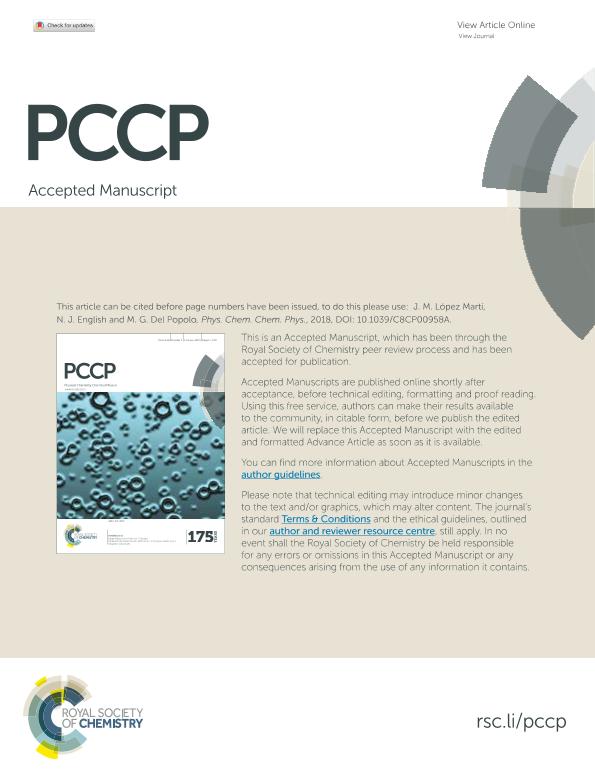Mostrar el registro sencillo del ítem
dc.contributor.author
López Martí, Jesús María
dc.contributor.author
English, Niall J.

dc.contributor.author
del Popolo, Mario Gabriel

dc.date.available
2020-03-25T15:06:49Z
dc.date.issued
2018-06
dc.identifier.citation
López Martí, Jesús María; English, Niall J.; del Popolo, Mario Gabriel; Elucidating mysteries of phase-segregated membranes: Mobile-lipid recruitment facilitates pores' passage to the fluid phase; Royal Society of Chemistry; Physical Chemistry Chemical Physics; 20; 28; 6-2018; 19234-19239
dc.identifier.issn
1463-9076
dc.identifier.uri
http://hdl.handle.net/11336/100682
dc.description.abstract
Phase segregation of multicomponent lipid bilayers leads to, under phase-coexistence conditions, domain formation, featuring delimitation by essentially one-dimensional borders. (Micro-)phase segregation of bilayers is proposed to influence the physiological behaviour of cell membranes and provides the driving force for lipid-raft formation. Experiments show a maximum in the electrical-conductivity of membranes at the phase-transition point, which has been conjectured to arise from border-nucleated transmembrane-conducting defects or pores. However, recent electroporation experiments on phase-segregated bilayers demonstrate electro-pore detection in the liquid disordered phase (Ld), wherein they diffuse over macroscopic periods without absorption into the liquid ordered phase (Lo). Here, we scrutinise transmembrane-pore formation via molecular dynamics simulations on a multicomponent phase-segregated bilayer. We find that pores created in Lo domains always migrate spontaneously to the Ld phase, via 'recruitment' of unsaturated lipids to the pore's rim to transport the pore to the fluid phase under a large stress-field driving force. Once in Ld domains, pores migrate towards their centre, never returning or pinning to Lo. These findings are explained by thermodynamics. By comparing the free-energy cost for creating pores in the bulk of Ld and Lo membranes, and in the phase-segregated system, we show that it is always more energetically tractable to create pores in Ld domains, independent of the pore size.
dc.format
application/pdf
dc.language.iso
eng
dc.publisher
Royal Society of Chemistry

dc.rights
info:eu-repo/semantics/openAccess
dc.rights.uri
https://creativecommons.org/licenses/by-nc-sa/2.5/ar/
dc.subject
Simulaciones
dc.subject.classification
Físico-Química, Ciencia de los Polímeros, Electroquímica

dc.subject.classification
Ciencias Químicas

dc.subject.classification
CIENCIAS NATURALES Y EXACTAS

dc.title
Elucidating mysteries of phase-segregated membranes: Mobile-lipid recruitment facilitates pores' passage to the fluid phase
dc.type
info:eu-repo/semantics/article
dc.type
info:ar-repo/semantics/artículo
dc.type
info:eu-repo/semantics/publishedVersion
dc.date.updated
2020-03-18T20:33:23Z
dc.journal.volume
20
dc.journal.number
28
dc.journal.pagination
19234-19239
dc.journal.pais
Reino Unido

dc.journal.ciudad
Cambridge
dc.description.fil
Fil: López Martí, Jesús María. Universidad Nacional de Cuyo. Facultad de Ciencias Exactas y Naturales; Argentina
dc.description.fil
Fil: English, Niall J.. University College Dublin; Irlanda
dc.description.fil
Fil: del Popolo, Mario Gabriel. Consejo Nacional de Investigaciones Científicas y Técnicas. Centro Científico Tecnológico Conicet - Mendoza; Argentina. Universidad Nacional de Cuyo. Facultad de Ciencias Exactas y Naturales; Argentina
dc.journal.title
Physical Chemistry Chemical Physics

dc.relation.alternativeid
info:eu-repo/semantics/altIdentifier/url/http://pubs.rsc.org/en/Content/ArticleLanding/2018/CP/C8CP00958A
dc.relation.alternativeid
info:eu-repo/semantics/altIdentifier/doi/http://dx.doi.org/10.1039/C8CP00958A
Archivos asociados
